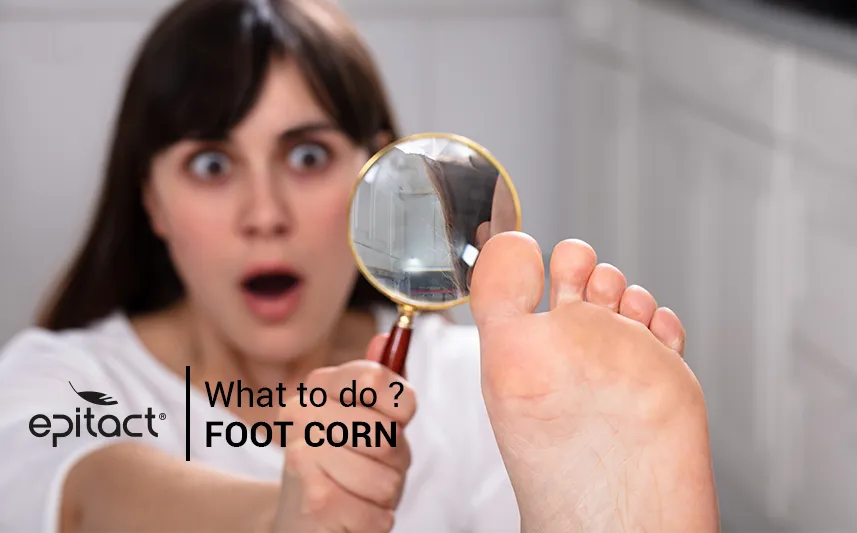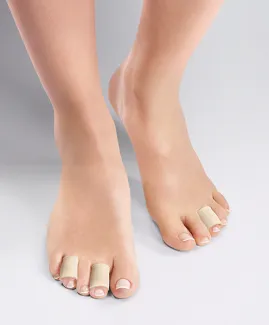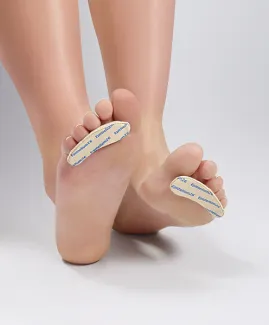
You have a corn on your toe or under your foot that is painful? Do you know that there are different types of corns on the feet? Indeed, there are two main categories: hard corns on top of toes, at the end of toes or under the foot and soft corns between toes. Also, you have several types of corns like neurovascular and vascular corns, fibrous and seed corns.
EPITACT® describes you what is a corn on foot, why it is painful and how to relieve it.
What is a foot corn?
A foot corn is a localised thickening of the skin that forms to protect it from repeated rubbing and pressure. Most of the time, it appears on bony prominences, usually the joints and especially those which face a lot of pressure. The most affected parts of the foot are the top of the toes and the ball of the foot.
Why are corns on the foot so painful?
A corn is composed of a round and dense core made up of keratin which has an inverted cone-shape that reaches the deep layers of the skin. So, during your activities, the ground or the shoe presses your skin and this pointy-shape core causes sharp pain.
Sometimes, the corn on the toe can be inflamed. It is surrounded by red, feels hot and pain increases. Also, some corns on the foot can exert pressure on a nerve, causing intense pain.
How do you get corns on your toes?
Corns on the feet appear progressively. If you are addicted to high heels or pointy and narrow shoes, be aware that you’re inflicting a daily torture on your toes. By being constricted one against another in tight shoes for too long, your toes create a shield to protect themselves. The more the corns on toes become bigger, the more the toes are lacking room. Also, everything that adds pressure on the corn is a risk factor. It can be the shoes, foot deformities like hallux valgus, hammer toes or flat feet, some kind of sports, dry skin and being overweight.
What is a corn on foot compared with a callus?
Corns and calluses are both callosities characterised by a thickening of skin on the feet or hands. However, a corn on foot is smaller and deeper than a callus and mainly affects the toes. On the contrary, a callus more often develops on the ball of the foot. It also has a yellowish colour whereas a corn is whitish with a little point in the centre showing the excess of pressure that this area suffered.
The different types of corns on feet
Corns on the foot are small lesions on the skin. They can be confused with other foot problems, namely calluses or plantar warts for example. Note that plantar warts can form anywhere on the foot. To identify corns better, learn about the different types of corns on feet.
• Hard corns have a hard and whitish keratin core. They appear on top of the toes (dorsal corn), at their end (distal corn) or on the ball of the foot (plantar corn).
• Soft corns develop on damp areas of the foot, mainly between two toes (most of the time between the fourth toe and the little toe). They are also called interdigital corns. They have a whitish spongy core, and are often surrounded by red, which is a sign of inflammation.
• Vascular corns on the foot have little blood vessels in them, which bleed very easily.
• Neurovascular corns are corns that compress a nerve ending. Their removal is very painful.
• Seed corns on foot are tiny corns which appear as a collection of small corns. They are usually painless.
• Fibrous corns are corns that have been present for a long time with no treatment and begin to attach to deeper tissue. They can be very uncomfortable.
What to do to relieve a corn on toe?
There are several solutions to prevent and relieve corns on toes, namely:
1) Go to a shoe shop and choose shoes with a wide toe box. They should also be flat or with a low heel. In summer, wide and open shoes will allow them total freedom.
2) Your podiatrist can give you adequate care aiming to eliminate dead skin and calluses.
3) Improve your daily comfort thanks to the EPITACT® range of corn pads for feet. They distribute pressure on the toe corn and limit rubbing between your toes themselves or against the shoe:
- The DIGITUBES® protections* isolate the toe from the shoe and its neighbours and help to remove corns on top on toes or soft corns between toes.
- The Digitops* help to prevent and relieve corns at the end of a toe.
- To stretch your toes out and limit conflicts with your shoes, EPITACT® recommends you the hammer toe cushions*. These are better if you suffer multiple corns on your toes.
You have discovered what is a corn on foot, its main causes and the ways to relieve corns on toes with EPITACT®. Now, read the next article about their causes and try to avoid them.
*These solutions are class I medical devices that bear the CE marking under this regulation. Carefully read the instructions before use. Manufacturer: Millet Innovation. 05/2021.
 Pharmacie
Pharmacie

